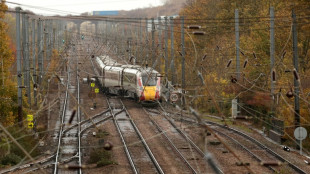-
 'Heroic' worker praised as man charged over UK train stabbings
'Heroic' worker praised as man charged over UK train stabbings
-
Bangladesh ex-PM Zia to contest elections: party

-
 Tanzania president sworn in as opposition says hundreds killed in protests
Tanzania president sworn in as opposition says hundreds killed in protests
-
India announces $5.75 million reward for women cricket World Cup winners

-
 Spain regional leader resigns, a year after deadly floods
Spain regional leader resigns, a year after deadly floods
-
Video game creators fear AI could grab the controller

-
 France threatens Shein ban if 'childlike' sex dolls reappear
France threatens Shein ban if 'childlike' sex dolls reappear
-
International cricket returns to Faisalabad with Pakistan-South Africa ODIs

-
 Afghan govt says quake kills 20, injures over 500
Afghan govt says quake kills 20, injures over 500
-
'We're all too rich,' says photo legend Martin Parr

-
 Tanzania president inaugurated as opposition says hundreds dead
Tanzania president inaugurated as opposition says hundreds dead
-
Shafali Verma: India's World Cup hero who disguised herself as boy

-
 Most equity markets rise on lingering trader optimism
Most equity markets rise on lingering trader optimism
-
Afghanistan quake kills 20, injures over 300: health ministry

-
 India hails maiden women's World Cup cricket title as game-changer
India hails maiden women's World Cup cricket title as game-changer
-
As clock ticks down, Greece tries to clean up its act on waste

-
 Local fabrics, fibres shine at eco-centred Lagos Fashion Week
Local fabrics, fibres shine at eco-centred Lagos Fashion Week
-
Spalletti bidding to revive Juve and reputation ahead of Sporting visit in Champions League

-
 Tanzania president to be inaugurated as opposition says hundreds dead
Tanzania president to be inaugurated as opposition says hundreds dead
-
Bouanga brace as LAFC beats Austin 4-1 to advance in MLS Cup playoffs

-
 'Golden age': Japan hails Yamamoto, Ohtani after Dodgers triumph
'Golden age': Japan hails Yamamoto, Ohtani after Dodgers triumph
-
Thunder roll over Pelicans to remain NBA's lone unbeaten team

-
 Hong Kong legislature now an 'echo chamber', four years after shake-up
Hong Kong legislature now an 'echo chamber', four years after shake-up
-
Most Asian markets rise on lingering trader optimism

-
 Andrew to lose his last military rank: defence minister
Andrew to lose his last military rank: defence minister
-
Trump's global tariffs to face challenge before Supreme Court

-
 Barnstorming Bayern face acid test at reigning champions PSG
Barnstorming Bayern face acid test at reigning champions PSG
-
Alonso shaping new Real Madrid on Liverpool return

-
 Half Yours favourite at Australia's 'race that stops a nation'
Half Yours favourite at Australia's 'race that stops a nation'
-
Tonga rugby league star has surgery after 'seizure' against NZ

-
 Trent's return with Real Madrid reminds Liverpool of what they are missing
Trent's return with Real Madrid reminds Liverpool of what they are missing
-
Tehran toy museum brings old childhood memories to life

-
 Iran banking on Iraq vote to retain regional influence
Iran banking on Iraq vote to retain regional influence
-
Daughter of 'underground' pastor urges China for his release

-
 Trump the Great? President steps up power moves
Trump the Great? President steps up power moves
-
Fire ravages French monastery dubbed 'Notre-Dame of the Ardennes'

-
 Bills outlast Chiefs while NFL-best Colts fall to Steelers
Bills outlast Chiefs while NFL-best Colts fall to Steelers
-
NBA champion Thunder roll over Pelicans to remain unbeaten

-
 Scam Encounters Every Four Days: Mexico's Financial Toll
Scam Encounters Every Four Days: Mexico's Financial Toll
-
Eliud Kipchoge unveils plan to run 7 marathons on 7 continents

-
 Milan deny Roma top spot in Serie A, Inter beat Verona
Milan deny Roma top spot in Serie A, Inter beat Verona
-
Lens back up to third in Ligue 1 as Lyon held at Brest

-
 NFL-best Colts fall to Steelers, Packers lose to Carolina
NFL-best Colts fall to Steelers, Packers lose to Carolina
-
'Regretting You' wins spooky slow N. American box office

-
 'Just the beginning' as India lift first Women's World Cup
'Just the beginning' as India lift first Women's World Cup
-
Will Still sacked by struggling Southampton

-
 Malinin wins Skate Canada crown with stunning free skate
Malinin wins Skate Canada crown with stunning free skate
-
Barca beat Elche to recover from Clasico loss

-
 Jamaica deaths at 28 as Caribbean reels from colossal hurricane
Jamaica deaths at 28 as Caribbean reels from colossal hurricane
-
Verma and Sharma power India to first Women's World Cup triumph

Tokyo’s Housing playbook
Tokyo is the global outlier: a megacity that keeps housing comparatively affordable by continually adding homes where people want to live. While most world capitals saw rents and prices surge over the past decade, Tokyo’s core has absorbed population and job growth with steady construction, friction-light planning, and transport-led density. The result is a market that feels tight, but not prohibitive, especially measured against incomes and against other alpha cities.
A supply engine that rarely stalls
By-right building and flexible zoning. Tokyo’s national and metropolitan rules concentrate on managing externalities (sunlight, noise, fire safety) rather than prescribing narrow building forms. With broad residential/commercial categories and generous floor-area ratios on transit corridors, projects that meet code typically proceed without political hearings or discretionary up-zoning battles.
Short, predictable approvals. Standardized codes and professionalized review compress time-to-permit, lowering finance risk and encouraging small and mid-sized developers to build continuously rather than only in booms.
Rebuild culture. Earthquake codes, depreciation schedules and a consumer preference for new stock mean frequent teardown-and-rebuild cycles. Even on tiny lots, owners routinely add units or convert to small apartment buildings, incrementally densifying neighborhoods.
Transit makes density livable—and bankable
Private rail drives housing. Tokyo’s private railways integrate stations, shopping, offices and large volumes of mid-rise housing around their lines. Ticket revenue is only part of the business model; property income and development rights fund frequent service and station upgrades.
Unlimited “15-minute” catchments. Because most residents live near frequent rail, mid-rise density scales across dozens of hubs, not just the CBD. That spreads demand—and construction—over a vast footprint, preventing a handful of postcodes from overheating.
Institutions that add capacity
Public/semipublic landlords. Agencies such as the Urban Renaissance (UR) group, municipal corporations and housing cooperatives provide tens of thousands of no-frills, well-located rentals. These aren’t deep-subsidy projects; they are steady, middle-market supply that anchors rents.
Condominiums and rentals grow together. Developers deliver both for-sale condos and purpose-built rentals, so investors don’t have to outbid first-time buyers to add stock. A liquid mortgage market and still-low borrowing costs support new starts even when global rates rise.
Prices, rents and incomes: the relative picture
- Rents are high—but not New York/London high. Typical inner-ward one-bedroom rents remain far below peer megacities when converted at purchasing-power parity. Commuter-line hubs two or three stops from Shinjuku or Tokyo Station offer modern 1LDK units at prices that service workers can realistically afford—without hour-long car commutes.
- Incomes track shelter costs better than elsewhere. On standard measures (price-to-income, price-to-rent), Japan’s trend since the mid-2010s has been flatter than most OECD countries. Tokyo has seen pockets of luxury inflation, but the citywide rent and price indices have grown far more slowly than in North America or Western Europe.
- Volume matters. Even with nationwide housing starts easing in 2023–2024, Greater Tokyo continues to add substantial numbers of dwellings each year, especially along infill rail corridors and in redevelopment districts (Shibuya, Shinagawa, Toyosu, Kachidoki).
Why the system resists scarcity
- Politics aligns with building. Because zoning is permissive citywide, there’s less incentive for neighborhood vetoes or speculative land banking tied to hearings.
- Small lots, small builders. A fragmented development ecology turns thousands of micro-sites into duplexes and 3–10-unit walk-ups, the “missing middle” that many cities lack.
- Elastic density near jobs. Station-area rules allow extra floor area for mixed-use, family-sized units and open space, so growth concentrates where services exist.
What could change
- Aging construction workforce may raise costs and slow output unless training and immigration expand.
- Materials inflation and redevelopment of marquee sites can pull contractors toward luxury segments if not counterbalanced by steady mid-market programs.
- Demographic shifts—Tokyo’s net in-migration has already slowed—could rebalance demand across the metro, altering where affordability is best.
The takeaways for other megacities
- Make most housing legal by default; reserve politics for genuine impacts, not routine approvals.
- Let transit operators profit from development so they have reason to add service and stations.
- Cultivate small builders and small lots; mass only high-rises won’t close the gap.
- Keep a neutral, middle-market rental sector that adds units year-in, year-out.
- Measure success in permits and completions, not just plans.
Tokyo’s achievement isn’t magic. It is a long-running, systems-level commitment to abundant, transit-served housing—and a regulatory culture that treats new homes as a feature, not a problem.

Gaza on the cusp of civil war

Israel: Economy on the edge

Why Russia can’t end war

Rare Earth Standoff

Tanks in Gaza - Hopes dim?

Poland trusts only hard Power

Cuba's hunger Crisis deepens

How Swiss Stocks tamed Prices

Russia's Drone ploy in Poland

Why Nepal is burning

Milei suffers crushing Defeat




